Miami-Dade County, Florida
Miami-Dade County is a county located in the southeastern part of the U.S. state of Florida. The county had a population of 2,701,767 as of the 2020 census,[7] making it the most populous county in Florida and the seventh-most populous county in the United States.[8] It is also Florida's third largest county in terms of land area, with 1,946 square miles (5,040 km2). The county seat is Miami, the core of the nation's ninth largest and world's 34th largest metropolitan area with a 2020 population of 6.138 million people.[9]
Miami-Dade County, Florida | |
|---|---|
  .jpg.webp)  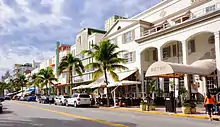 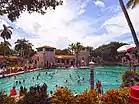    Images, from top down, left to right: Downtown Miami skyline; Lifeguard station on South Beach; Miami Design District's Palm Court; Wynwood Walls in Wynwood Art District; Ocean Drive in Miami Beach; Venetian Pool; Anhinga Trail boardwalk in Everglades National Park; FTX Arena; Biscayne National Park | |
 Flag  Seal Logo | |
| Nickname(s): "Dade County", "Dade", "Metro-Dade", "Greater Miami" | |
| Motto: Delivering Excellence Every Day | |
 | |
 Miami-Dade County, Florida Location within the United States | |
| Coordinates: 25°36′38″N 80°29′50″W[1] | |
| Country | |
| State | |
| Region | South Florida |
| Metro area | Miami |
| Founded | January 18, 1836 |
| Named for | Francis L. Dade |
| County seat and largest city | |
| Incorporated municipalities | 34 |
| Government | |
| • Type | Two-tier federation |
| • Body | Miami-Dade Board of County Commissioners |
| • Miami-Dade Board of County Commissioners[2] | Commissioners
|
| • Mayor of Miami-Dade County | Daniella Levine Cava (D) |
| Area | |
| • Total | 2,431.178 sq mi (6,296.72 km2) |
| • Land | 1,898.753 sq mi (4,917.75 km2) |
| • Water | 532.425 sq mi (1,378.97 km2) 21.9% |
| Highest elevation [3] (Miami Rock Ridge) | 30 ft (9 m) |
| Lowest elevation | 0 ft (0 m) |
| Population (2020)[4] | |
| • Total | 2,701,767 |
| • Estimate (2019)[5] | 2,716,940 |
| • Density | 1,422.92/sq mi (549.39/km2) |
| Demonym | Miami-Dadian |
| Time zone | UTC−5 (Eastern Time Zone) |
| • Summer (DST) | UTC−4 (Eastern Daylight Time) |
| Zip Code | 33002, 33010-33018, 33030-33035, 33039, 33054, 33056, 33090, 33092, 33101-33102, 33106, 33109, 33111-33112, 33114, 33116, 33119, 33122, 33124-33147, 33149-33158, 33160-33170, 33172-33199, 33206, 33222, 33231, 33233-33234, 33238-33239, 33242-33243, 33245, 33247, 33255-33257, 33261, 33265-33266, 33269, 33280, 33283, 33296, 33299 |
| Area codes | 305/786, |
| FIPS code | 12086 |
| GNIS feature ID | 295755 |
| GDP | $146 billion[6] |
| Primary Airport | Miami International Airport (MIA) |
| Secondary Airport |
|
| Interstates | |
| U.S. Routes | |
| State Routes | |
| Rapid Transit | Metrorail |
| Commuter Rail | Amtrak, Brightline, Tri-Rail |
| Website | www |
Miami-Dade County is heavily Hispanic, and was the most populous majority-Hispanic county in the nation as of 2020. It is home to 34 incorporated cities and many unincorporated areas.[10] The northern, central and eastern portions of the county are heavily urbanized with many high-rise buildings along the coastline, including Miami's Central Business District in Downtown Miami. Southern Miami-Dade County includes the Redland and Homestead areas, which make up the agricultural economy of the county. Agricultural Redland makes up roughly one third of Miami-Dade County's inhabited land area, and is sparsely populated, a stark contrast to the densely populated, urban portions of the county northern sections.
The county also includes portions of two national parks. To the west, the county extends into the Everglades National Park and is populated only by a Miccosukee tribal village. Biscayne National Park and the Biscayne Bay Aquatic Preserves are located east of the mainland in Biscayne Bay.[11][12]
History
Native people
The earliest evidence of Native American settlement in the Miami region came from about 12,000 years ago.[13] The first inhabitants settled on the banks of the Miami River, with the main villages on the northern banks.
The inhabitants at the time of first European contact were the Tequesta people, who controlled much of southeastern Florida, including what is now Miami-Dade County, Broward County, and the southern part of Palm Beach County. The Tequesta Indians fished, hunted, and gathered the fruit and roots of plants for food, but did not practice agriculture. They buried the small bones of the deceased with the rest of the body, and put the larger bones in a box for the village people to see. The Tequesta are credited with making the Miami Circle.[14]
European explorers and settlers
Juan Ponce de León was the first European to visit the area in 1513 by sailing into Biscayne Bay. His journal records he reached Chequescha, a variant of Tequesta, which was Miami's first recorded name.[15] It is unknown whether he came ashore or made contact with the natives. Pedro Menéndez de Avilés and his men made the first recorded landing when they visited the Tequesta settlement in 1566 while looking for Avilés' missing son, shipwrecked a year earlier.[16] Spanish soldiers led by Father Francisco Villarreal built a Jesuit mission at the mouth of the Miami River a year later but it was short-lived. After the Spaniards left, the Tequesta Indians were left to fend themselves from European-introduced diseases like smallpox. By 1711, the Tequesta sent a couple of local chiefs to Havana, Cuba, to ask if they could migrate there. The Cubans sent two ships to help them, but Spanish illnesses struck and most of the Tequesta died.[17]
The first permanent European settlers arrived in the early 19th century. People came from the Bahamas to South Florida and the Keys to hunt for treasure from the ships that ran aground on the treacherous Great Florida Reef. Some accepted Spanish land offers along the Miami River. At about the same time, the Seminole Indians arrived, along with a group of runaway slaves. The area was affected by the Second Seminole War, during which Major William S. Harney led several raids against the Indians. Most non-Indian residents were soldiers stationed at Fort Dallas. It was the most devastating Indian war in American history, causing almost a total loss of population in Miami.
After the Second Seminole War ended in 1842, William English re-established a plantation started by his uncle on the Miami River. He charted the "Village of Miami" on the south bank of the Miami River and sold several plots of land. In 1844, Miami became the county seat, and six years later a census reported there were ninety-six residents in the area.[18] The Third Seminole War was not as destructive as the second, but it slowed the settlement of southeast Florida. At the end of the war, a few of the soldiers stayed.
Establishment
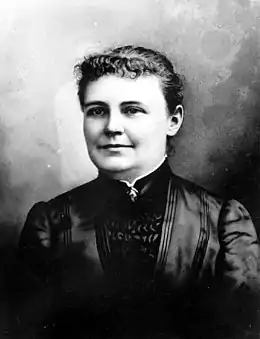
Dade County was created on January 18, 1836, under the Territorial Act of the United States. The county was named after Major Francis L. Dade, a soldier killed in 1835 in the Second Seminole War, at what has since been named the Dade Battlefield.[19] At the time of its creation, Dade County included the land that now contains Palm Beach and Broward counties, together with the Florida Keys from Bahia Honda Key north and the land of present-day Miami-Dade County. The county seat was originally at Indian Key in the Florida Keys; then in 1844, the County seat was moved to Miami. The Florida Keys from Key Largo to Bahia Honda were returned to Monroe County in 1866. In 1888 the county seat was moved to Juno, near present-day Juno Beach, Florida, returning to Miami in 1899. In 1909, Palm Beach County was formed from the northern portion of what was Dade County, and then in 1915, Palm Beach County and Dade County contributed nearly equal portions of land to create what is now Broward County. There have been no significant boundary changes to the county since 1915.[20][21][22]
Hurricanes
The third-costliest natural disaster to occur in the United States was Hurricane Andrew, which hit Miami in the early morning of Monday, August 24, 1992. It struck the southern part of the county from due east, south of Miami and very near Homestead, Kendall, and Cutler Ridge (now the Town of Cutler Bay). Damages numbered over US$25 billion in the county alone, and recovery has taken years in these areas where the destruction was greatest. This was the costliest natural disaster in US history until Hurricane Katrina struck the Gulf region in 2005.
Name change
On November 13, 1997, voters changed the name of the county from Dade to Miami-Dade to acknowledge the international name recognition of Miami.[23] Voters were acting pursuant to home rule powers granted to Dade County, including the ability to change the name of the county without the consent of the Florida Legislature.[24] The change in name also addressed a source of public dissatisfaction with the name "Dade" which was chosen to honor Francis L. Dade, who had been killed in the Dade battle in the 1830s. The massacre did not occur in South Florida, but in the west central part of the state, in present-day Sumter County, near Bushnell. There is also a Dade City, which is closer to the site of the massacre.
Miami-Dade is the only hyphenated county name in the United States (although Alaska's Matanuska-Susitna Borough is similarly adorned).
Geography

| Miami, Florida[25] | ||||||||||||||||||||||||||||||||||||||||||||||||||||||||||||
|---|---|---|---|---|---|---|---|---|---|---|---|---|---|---|---|---|---|---|---|---|---|---|---|---|---|---|---|---|---|---|---|---|---|---|---|---|---|---|---|---|---|---|---|---|---|---|---|---|---|---|---|---|---|---|---|---|---|---|---|---|
| Climate chart (explanation) | ||||||||||||||||||||||||||||||||||||||||||||||||||||||||||||
| ||||||||||||||||||||||||||||||||||||||||||||||||||||||||||||
| ||||||||||||||||||||||||||||||||||||||||||||||||||||||||||||
According to the U.S. Census Bureau, the county has an area of 2,431 square miles (6,300 km2), of which 1,898 square miles (4,920 km2) is land and 533 square miles (1,380 km2) (21.9%) is water.[26] It is the third-largest county in Florida by land area and second-largest by total area. Most of the water is in the Biscayne Bay, with another significant portion in the adjacent Atlantic Ocean.
Miami-Dade County is only about 6 feet (1.8 m) above sea level. It is rather new geologically and is at the eastern edge of the Florida Platform, a carbonate plateau created millions of years ago. Eastern Dade is composed of Oolite limestone while western Dade is composed mostly of Bryozoa.[27] Miami-Dade is among the last areas of Florida to be created and populated with fauna and flora, mostly in the Pleistocene.
The bay is divided from the Atlantic Ocean by many barrier islands along the coast. The city of Miami Beach, home to the South Beach neighborhood and its Art Deco district, is built on these barrier islands. The archipelago of the Florida Keys, which extends in an arc to the south-southwest, is only accessible through Miami-Dade County, although most of the Keys are part of neighboring Monroe County. Miami is sixty-five miles from West Palm Beach, and thirty miles from Fort Lauderdale.
Communities
Miami-Dade County includes 34 incorporated areas, 38 census-designated places, and 16 unincorporated regions.
Adjacent counties
- Broward County – north
- Monroe County – southwest
- Collier County – northwest
National protected areas
- Big Cypress National Preserve
- Biscayne National Park
- Everglades National Park
Demographics
| Historical population | |||
|---|---|---|---|
| Census | Pop. | %± | |
| 1840 | 446 | — | |
| 1850 | 159 | −64.3% | |
| 1860 | 83 | −47.8% | |
| 1870 | 85 | 2.4% | |
| 1880 | 257 | 202.4% | |
| 1890 | 861 | 235.0% | |
| 1900 | 4,955 | 475.5% | |
| 1910 | 11,933 | 140.8% | |
| 1920 | 42,753 | 258.3% | |
| 1930 | 142,955 | 234.4% | |
| 1940 | 267,739 | 87.3% | |
| 1950 | 495,084 | 84.9% | |
| 1960 | 935,047 | 88.9% | |
| 1970 | 1,267,792 | 35.6% | |
| 1980 | 1,625,781 | 28.2% | |
| 1990 | 1,937,094 | 19.1% | |
| 2000 | 2,253,362 | 16.3% | |
| 2010 | 2,496,435 | 10.8% | |
| 2020 | 2,701,767 | 8.2% | |
| U.S. Decennial Census[28] 1790–1960[29] 1900–1990[30] 1990–2000[31] 2010–2019[32] | |||
2020 U.S. Census
| Race | Pop 2010 | Pop 2020 | % 2010 | % 2020 |
|---|---|---|---|---|
| White (Non-Hispanic) | 383,551 | 361,517 | 15.36% | 13.38% |
| Black or African American (Non-Hispanic) | 425,650 | 378,756 | 17.05% | 14.02% |
| Native American or Alaska Native (Non-Hispanic) | 2,014 | 1,589 | 0.07% | 0.06% |
| Asian (Non-Hispanic) | 35,841 | 41,672 | 1.44% | 1.54% |
| Pacific Islander (Non-Hispanic) | 468 | 385 | 0.02% | 0.01% |
| Some Other Race (Non-Hispanic) | 4,953 | 14,667 | 0.2% | 0.54% |
| Mixed/Multi-Racial (Non-Hispanic) | 20,099 | 46,243 | 0.81% | 1.71% |
| Hispanic or Latino | 1,623,859 | 1,856,938 | 65.05% | 68.73% |
| Total | 2,496,435 | 2,701,767 | 100% | 100% |
As of the 2020 United States census, there were 2,701,767 people, 912,805 households, and 633,834 families residing in the county.
2010 U.S. Census
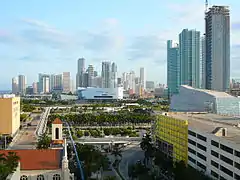
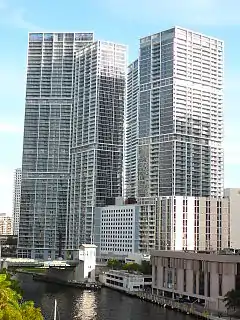
U.S. Census Bureau 2010 ethnic/race demographics:[35][36]
- Hispanic or Latino of any race: 65.0%[36][37]
- White (non-Hispanic): 15.4% (White total 73.8% when including White Hispanics)[35]
- Black (non-Hispanic): 17.1% (Black total 18.9% when including Black Hispanics)[38]
- Asian: 1.5%[35][36]
- Two or more races: 2.4%
- American Indian and Alaska Native: 0.2%
- Native Hawaiian and Other Pacific Islander: <0.1%[35][36]
- Other Races: 3.2% (0.6% Arab)[35]
In 2010, the largest ancestry groups were:[35]
In 2010, Cubans made up the largest population of immigrants (with more than half of the population) with Colombians coming in second, Haitians in third, followed by Nicaraguans in fourth place, then Dominicans, Venezuelans, Peruvians, Jamaicans, Mexicans, and Argentinians among the highest group of immigrants.[39]
Miami-Dade has small communities of Brazilians, Portuguese, Spaniards, Ukrainians and Poles along with Canadians (including Francophone from the province of Quebec), French, Germans, other Europeans, British expatriates and Israelis.
There were 867,352 households, out of which 30.6% had children under the age of 18 living with them, 43.8% were married couples living together, 18.8% had a female householder with no husband present, and 30.5% were non-families. 23.6% of all households were made up of individuals, and 8.4% (2.5% male and 5.9% female) had someone living alone who was 65 years of age or older. The average household size was 2.83 and the average family size was 3.33.[36][40]
The age distribution is 21.9% under the age of 18, 9.9% from 18 to 24, 28.6% from 25 to 44, 25.6% from 45 to 64, and 14.1% who were 65 years of age or older. The median age was 38.2 years. For every 100 females, there were 93.8 males. For every 100 females age 18 and over, there were 91.0 males.[40]
The median income for a household in the county was $43,605, and the median income for a family was $50,065. Males had a median income of $35,096 versus $29,980 for females. The per capita income for the county was $22,957. About 13.8% of families and 17.2% of the population were below the poverty line, including 22.0% of those under age 18 and 22.1% of those aged 65 or over.[41]
In 2010, 51.1% of the county's population was foreign born, with 48.7% being naturalized American citizens. Of foreign-born residents, 93.0% were born in Latin America, 3.2% were born in Europe, 2.7% born in Asia, 0.5% born in Africa, 0.5% in North America, and 0.1% were born in Oceania.[35]
| Population | Miami-Dade |
|---|---|
| 2018 Estimate | 2,761,581 |
| 2010 Census | 2,496,435 |
| 2000 Census | 2,253,362 |
| 1990 Census | 1,937,094 |
2000 U.S. Census
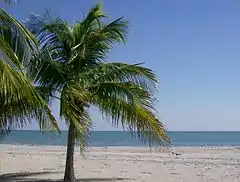
As of the census of 2000, there were 2,253,362 people, 776,774 households, and 548,402 families in the county, with an average population density of 1,158 inhabitants per square mile (447/km2). There were 852,278 housing units, with an average density of 438 per square mile (169/km2). The county's racial makeup was 69.7% White (49% White Hispanic, 20.7% Non-Hispanic White),[44] 20.3% African American and Black (with a large part of Caribbean descent), 0.2% Native American, 1.4% Asian, <0.1% Pacific Islander, 4.60% from other races, and 3.8% from two or more races. 57.3% of the population were Hispanic or Latino of any race. In relation to ancestry (excluding the various Hispanic and Latino ancestries), 5% were Haitian, 5% American, 2% Italian, 2% Jamaican, 2% German, 2% Irish, and 2% English ancestry.[45]
There were 776,774 households, out of which 33.8% had children under the age of 18 living with them, 47.7% were married couples living together, 17.2% had a female householder with no husband present, and 29.4% were non-families. 23.3% of all households were made up of individuals, and 8.6% had someone living alone who was 65 years of age or older. The average household size was 2.84 and the average family size was 3.35.
The age distribution is 24.8% under the age of 18, 9.1% from 18 to 24, 31.0% from 25 to 44, 21.7% from 45 to 64, and 13.3% who were 65 years of age or older. The median age was 36 years. For every 100 females, there were 93.5 males. For every 100 females age 18 and over, there were 90.2 males.
The county's median household income was $35,966, and the median family income was $40,260. Males had a median income of $30,120 versus $24,686 for females. The county's per capita income was $18,497. About 14.5% of families and 18.0% of the population were below the poverty line, including 22.9% of those under age 18 and 18.9% of those age 65 or over.
Languages
As of 2010, 28.1% of the population spoke only English at home, while 63.8% of the population spoke Spanish, 4.2% spoke French Creole (mainly Haitian Creole), 0.6% French, and 0.6% Portuguese.[46] About 52% of the county residents were born outside the United States, while 71.9% of the population spoke a language other than English at home.[46]
Religious statistics
In 2010 statistics, the largest religious group in Miami-Dade County was the Archdiocese of Miami with 544,449 Catholics in 65 parishes, followed by 96,749 non-denominational adherents with 197 congregations, 80,123 SBC Baptists with 313 congregations, 47,921 NBC Baptists with 44 congregations, 27,901 Seventh-day Adventists in 62 congregations, 25,244 AoG Pentecostals with 45 congregations, 14,628 LDS Mormons with 18 congregations, 12,569 TEC Episcopalians with 30 congregations, and 11,880 UMC Methodists with 32 congregations. There is an estimated 23,064 Muslims with 15 congregations, 3,069 Hindus with 20 congregations, and 1,342 Buddhist with 22 congregations.[47]
In 2005 the Jewish population of the county has decreased but stabilized at about 121,000 with a high percentage of retired and elderly persons (but less than in Broward and Palm Beach counties). There are more than 60 congregations, 34 Jewish educational institutions, and three Jewish community centers. The highest percentage and increase in Jewish population is in North Dade, especially in Aventura. Miami-Dade County hosts Florida's third largest Jewish population and the nation's tenth largest.[47]
Altogether, 39.8% of the population was claimed as members by religious congregations, although members of historically African-American denominations were underrepresented due to incomplete information.[48] In 2014, Miami-Dade County had 731 religious organizations, the 14th most out of all US counties.[49]
Law, government, and politics

Miami-Dade County has operated under a metropolitan system of government, a "two-tier federation", since 1957. This was made possible when Florida voters approved a constitutional amendment in 1956 that allowed the people of Dade County (as it was known) to enact a home rule charter. Prior to this year, home rule did not exist in Florida, and all counties were limited to the same set of powers by the Florida Constitution and state law.
Unlike a consolidated city-county, where the city and county governments merge into a single entity, these two entities are separate. Instead there are two "tiers", or levels, of government: city and county. There are 34 municipalities in the county, the City of Miami being the largest.
Cities are the "lower tier" of local government, providing police and fire protection, zoning and code enforcement, and other typical city services within their jurisdiction. These services are paid for by city taxes. The County is the "upper tier", and it provides services of a metropolitan nature, such as emergency management, airport and seaport operations, public housing and health care services, transportation, environmental services, solid waste disposal etc. These are funded by county taxes, which are assessed on all incorporated and unincorporated areas.
Of the county's 2.6 million total residents (as of 2013), approximately 52% live in unincorporated areas, the majority of which are heavily suburbanized. These residents are part of the Unincorporated Municipal Services Area (UMSA). For these residents, the County fills the role of both lower- and upper-tier government, the County Commission acting as their lower-tier municipal representative body. Residents within UMSA pay a UMSA tax, equivalent to a city tax, which is used to provide County residents with equivalent city services (police, fire, zoning, water and sewer, etc.). Residents of incorporated areas do not pay UMSA tax.
Structure of county government
The Mayor of Miami-Dade County is elected countywide to serve a four-year term and is considered a "strong mayor". The mayor is not a member of the County Commission, appoints all 25 directors who oversee the operations of the County Departments and has veto power over the Commission. A mayoral appointment and veto can only be overridden by a two-thirds majority of the County Commission. The post is occupied by Daniella Levine Cava, the county’s first female mayor.
The Board of County Commissioners is the legislative body, consisting of 13 members elected from single-member districts. Members are elected to serve four-year terms, and elections of members are staggered. The Board chooses a Chairperson, who presides over the Commission, as well as appoints the members of its legislative committees. The Board has a wide array of powers to enact legislation, create departments, and regulate businesses operating within the County. It also has the power to override the Mayor's veto with a two-thirds vote.
Florida's Constitution provides for five elected officials to oversee executive and administrative functions for each county (called "Constitutional Officers"): Sheriff, Property Appraiser, Supervisor of Elections, Tax Collector, and Clerk of the Circuit Court (also functions as Comptroller).[51] However, the Constitution allows voters in home-rule counties (including Miami-Dade) to abolish the offices and reorganize them as subordinate County departments;[52] Miami-Dade voters chose this option for Sheriff, Supervisor of Elections, and Tax Collector.[53] The offices of Clerk of the Circuit Court, State Attorney, and Public Defender are still branches of State government and are, therefore, independently elected and not part of County government.[54]
Miami-Dade is the only county in Florida that does not have an elected sheriff or a "Sheriff's Office".[55] Instead, the county's law enforcement agency is known as the Miami-Dade Police Department, and its leader is known as the Metropolitan Sheriff and Director of the Miami-Dade Police Department; Nonetheless, Miami-Dade Police badges bear the inscription, "Deputy Sheriff, Sheriff's Office, Dade County, Fla."
Overview
Miami-Dade County has voted for the Democratic Party candidate in most of the presidential elections in the past four decades, and has gone Democratic in every election since 1992. However, it did vote twice for Ronald Reagan (1980, 1984) and once for George H. W. Bush (1988). From 1904 to 1972 it supported the Democratic candidate in all but four elections. The Democrats had expanded their winning margin in each of the three elections from 2008 to 2016; in 2008 and 2012, Democrat Barack Obama averaged 59.69% of the vote. In 2016, Democrat Hillary Clinton won 63.22% of the vote. However, in 2020, Democrat Joe Biden only won 53.31% of the vote, winning the county by just over seven percent over Republican Donald Trump. This was attributed to a large swing of Cuban Americans, Venezuelan Americans, and other Hispanic Americans to the Republican Party,[56] resulting in the best Republican performance since 2004.
Miami-Dade County is represented in the United States House of Representatives by Republicans Maria Elvira Salazar, Carlos Gimenez and Mario Diaz-Balart of the 27th, 26th and 25th districts, and Democrats Frederica Wilson and Debbie Wasserman Schultz of the 24th and 23rd districts.
| Year | Republican | Democratic | Third party | |||
|---|---|---|---|---|---|---|
| No. | % | No. | % | No. | % | |
| 2020 | 532,833 | 45.98% | 617,864 | 53.31% | 8,221 | 0.71% |
| 2016 | 333,999 | 33.83% | 624,146 | 63.22% | 29,046 | 2.94% |
| 2012 | 332,981 | 37.87% | 541,440 | 61.58% | 4,758 | 0.54% |
| 2008 | 360,551 | 41.70% | 499,831 | 57.81% | 4,254 | 0.49% |
| 2004 | 361,095 | 46.61% | 409,732 | 52.89% | 3,899 | 0.50% |
| 2000 | 289,574 | 46.29% | 328,867 | 52.57% | 7,111 | 1.14% |
| 1996 | 209,740 | 37.87% | 317,555 | 57.34% | 26,487 | 4.78% |
| 1992 | 235,313 | 43.19% | 254,609 | 46.73% | 54,921 | 10.08% |
| 1988 | 270,937 | 55.26% | 216,970 | 44.26% | 2,358 | 0.48% |
| 1984 | 324,414 | 59.17% | 223,863 | 40.83% | 35 | 0.01% |
| 1980 | 265,888 | 50.65% | 210,868 | 40.17% | 48,149 | 9.17% |
| 1976 | 211,148 | 40.45% | 303,047 | 58.06% | 7,747 | 1.48% |
| 1972 | 256,529 | 58.87% | 177,693 | 40.78% | 1,541 | 0.35% |
| 1968 | 135,222 | 37.02% | 176,689 | 48.37% | 53,391 | 14.62% |
| 1964 | 117,480 | 35.99% | 208,941 | 64.01% | 0 | 0.00% |
| 1960 | 134,506 | 42.35% | 183,114 | 57.65% | 0 | 0.00% |
| 1956 | 130,938 | 55.37% | 105,559 | 44.63% | 0 | 0.00% |
| 1952 | 122,174 | 56.77% | 93,022 | 43.23% | 0 | 0.00% |
| 1948 | 41,301 | 37.04% | 59,681 | 53.52% | 10,530 | 9.44% |
| 1944 | 30,357 | 33.56% | 60,100 | 66.44% | 0 | 0.00% |
| 1940 | 25,224 | 32.70% | 51,921 | 67.30% | 0 | 0.00% |
| 1936 | 10,295 | 26.88% | 28,007 | 73.12% | 0 | 0.00% |
| 1932 | 9,244 | 34.16% | 17,820 | 65.84% | 0 | 0.00% |
| 1928 | 15,860 | 60.15% | 10,136 | 38.44% | 372 | 1.41% |
| 1924 | 2,753 | 26.01% | 3,474 | 32.83% | 4,356 | 41.16% |
| 1920 | 3,077 | 38.09% | 4,288 | 53.08% | 713 | 8.83% |
| 1916 | 629 | 21.94% | 1,654 | 57.69% | 584 | 20.37% |
| 1912 | 99 | 5.56% | 1,171 | 65.71% | 512 | 28.73% |
| 1908 | 275 | 17.34% | 961 | 60.59% | 350 | 22.07% |
| 1904 | 307 | 24.08% | 887 | 69.57% | 81 | 6.35% |
| 1900 | 389 | 28.50% | 806 | 59.05% | 170 | 12.45% |
| 1896 | 368 | 46.46% | 372 | 46.97% | 52 | 6.57% |
| 1892 | 0 | 0.00% | 109 | 95.61% | 5 | 4.39% |
Voter registration
| Registered voters as of September 30, 2022[58] | ||
|---|---|---|
| Total population[5] | 2,701,767 (2020 census) | |
| Registered voters[59] | 1,522,460 | ~57% |
| Democratic | 575,556 | 37.80% |
| Republican | 436,037 | 28.64% |
| Democratic–Republican spread | +139,519 | +9.16% |
| Minor parties | 23,109 | 1.52% |
| No party preference | 487,758 | 32.04% |
Economy

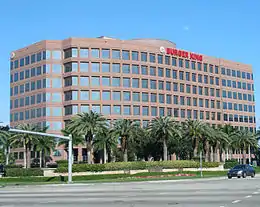
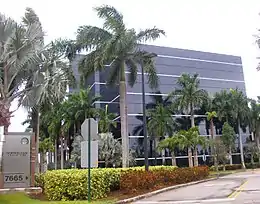

Brightstar Corporation,[62] Burger King,[63] Intradeco Holdings,[64] Latin Flavors,[65] Norwegian Cruise Line,[66] and Ryder have their headquarters in unincorporated areas in the county.[67] Centurion Air Cargo, Florida West International Airways, IBC Airways, and World Atlantic Airlines have their headquarters on the grounds of Miami International Airport in an unincorporated area in the county.[68][69][70][71][72]
Hewlett Packard's main Latin America offices are on the ninth floor of the Waterford Building in unincorporated Miami-Dade County.[73]
Other companies with offices in an unincorporated area not in any CDP:
- AstraZeneca's Latin American headquarters[74]
- Gate Group's Latin American headquarters[75]
- Unicomer Group's United States offices[76]
- Goya Foods's Miami office[77]
Several defunct airlines, including Airlift International, Arrow Air, National Airlines, and Rich International Airways, were headquartered on or near the airport property.[78][79][80][81]
After Frank Borman became president of Eastern Airlines in 1975, he moved Eastern's headquarters from Rockefeller Center in Midtown Manhattan, New York City to an unincorporated area in Miami-Dade County[82][83] Around 1991 the Miami-Dade County lost a few corporations, including Eastern Airlines, which folded in 1991.[84]
At one time the cruise line ResidenSea had its headquarters in an unincorporated area in the county.[85]
Top private employers
According to Miami's Beacon Council, the top private employers in 2014 in Miami-Dade were:[86]
| # | Employer | # of employees |
|---|---|---|
| 1 | University of Miami | 12,818 |
| 2 | Baptist Health South Florida | 11,353 |
| 3 | American Airlines | 11,031 |
| 4 | Carnival Cruise Line | 3,500 |
| 5 | Nicklaus Children's Hospital | 3,500 |
| 6 | Mount Sinai Medical Center | 3,321 |
| 7 | Florida Power & Light | 3,011 |
| 8 | Royal Caribbean International | 2,989 |
| 9 | Wells Fargo | 2,050 |
| 10 | Bank of America | 2,000 |
Top government employers
According to Miami's Beacon Council, the top government employers in 2014 in the county were:[86]
| # | Employer | # of employees |
|---|---|---|
| 1 | Miami-Dade County Public Schools | 33,477 |
| 2 | Miami-Dade County | 25,502 |
| 3 | U.S. federal government | 19,200 |
| 4 | Florida state government | 17,100 |
| 5 | Jackson Health System | 9,800 |
Agriculture
Most of the state's summer okra (Abelmoschus esculentus) is grown here,[87] totalling 1,000 to 1,500 acres (400 to 610 ha) over the whole year.[88] It is grown as a "scavenger crop", one grown to scavenge the benefits of residual fumigant and fertilizer.[87] The most problematic pest is the Melon Thrips (Thrips palmi) but aphids are also significant.[88] Although the Silverleaf Whitefly (Sweet Potato Whitefly, Bemisia tabaci) reproduces in large numbers on this crop, the plant is not seriously harmed and the feeding damage is quickly repaired.[88] This does still leave okra as a problematic refuge from which SLW will migrate, to nearby tomato, bean, and ornamentals.[88] The University of Florida provides a production handbook[89]: 235 which recommends disease management and weed management practices.
Methyl bromide (MB) has been phased out and Telone products – fumigants – are heavily regulated here.[89]: 46 M-D much more heavily regulates Telone than the rest of the state does.[89]: 46 Therefore the best MB alternatives here are either metam sodium or metam potassium, both combined with chloropicrin.[89]: 46
M-D has some of the lowest Cry 1F resistance in the country or Puerto Rico.[90] Despite its high volume of cargo traffic with PR and earlier speculation, none of PR's extreme Cry1F-r genetics seems to have spread to this area.[90] Southern Florida in general has the lowest in the country + PR.[90]
The state's first invasion of the Peach Fruit Fly (Bactrocera zonata) began here.[91] An adult male PFF was found on November 10th, 2010 on a guava tree (Psidium guajava).[91] The state responded by trapping an 81 square miles (210 km2) are around the site.[91]
The Little Fire Ant (Wasmannia auropunctata) is an invasive agricultural pest here.[92] In fact the first recorded invasion of the state was in 1924 in Coconut Grove (which was then near Miami and has since been incorporated into the city).[92][93]
Public services
Fire rescue
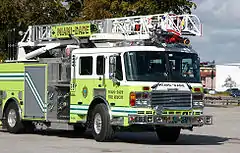
The Miami-Dade County Fire Rescue Department is the agency that provides fire protection and emergency medical services for Miami-Dade County, Florida. The department serves 29 municipalities and all unincorporated areas of Miami-Dade County from 60 fire stations.[94] The Department also provides fire protection services for Miami International Airport, Miami Executive Airport and Opa-locka Airport.[95]
The communities served are Aventura, Bal Harbour, Bay Harbor Islands, Biscayne Park, Cutler Bay, Doral, El Portal, Florida City, Golden Beach, Hialeah Gardens, Homestead, Indian Creek, Medley, Miami Gardens, Miami Lakes, Miami Shores, Miami Springs, North Bay Village, North Miami, North Miami Beach, Opa-locka, Palmetto Bay, Pinecrest, South Miami, Surfside, Sweetwater, Sunny Isles Beach, Virginia Gardens, and West Miami.[96]
Miami-Dade Fire Rescue is also the home to Urban Search and Rescue Florida Task Force 1 as well as EMS operations consisting of 57 Advanced Life Support units staffed by 760 state-certified paramedics and 640 state-certified emergency medical technicians.
Police department
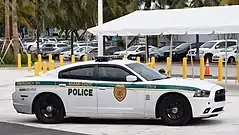
The Miami-Dade Police Department is a full-service metropolitan police department serving Miami-Dade County's unincorporated areas, although it has lenient mutual aid agreements with other municipalities, most often the City of Miami Police Department. With 4,700 employees, it is Florida's largest police department. The Department is often referred to by its former name, the Metro-Dade Police or simply Metro.
The Miami-Dade Police Department operates out of nine districts throughout the county and has two special bureaus. The director of the department is Juan Perez, who succeeded J.D. Patterson, Jr.[97] The Department's headquarters are in Doral, Florida.
Water and sewer department
Miami-Dade Water and Sewer Department (MDWASD) is one of the largest public utilities in the United States, employing approximately 2,700 employees as of 2007. It provides service to over 2.4 million customers, operating with an annual budget of almost $400 million. Approximately 330 million gallons of water are drawn every day from the Biscayne Aquifer for consumer use. MDWASD has over 7,100 miles (11,400 km) of water lines, a service area of 396 square miles (1,026 km2) and 14 pump stations. MDWASD has over 3,600 miles (5,800 km) of sewage pipes, a service area of 341 square miles (883 km2) and 954 pump stations.[98] Miami-Dade County is also in the jurisdiction of the South Dade Soil and Water Conservation District.
Corrections department
Miami-Dade County Corrections and Rehabilitation Department is the correction agency.
Aviation department
The Miami-Dade Aviation Department (MDAD) operates Miami International Airport, Miami Executive Airport, Opa-locka Executive Airport, Homestead General Aviation Airport, and Dade-Collier Training and Transition Airport.[99]
County representation
The Florida Department of Juvenile Justice operates the Miami-Dade Regional Juvenile Detention Center in an unincorporated area in the county.[100]
Public libraries
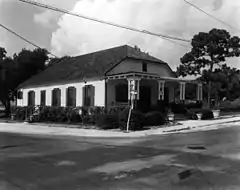
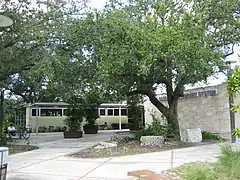
The Miami-Dade Public Library System traces its origin to the late nineteenth century. The first library was a reading room established in Lemon City on April 7, 1894 by the Lemon City Library and Improvement Association. In 1942 neighborhood libraries were brought together in a single public library system, governed by a Board of Trustees and administered by a Head Librarian. A new central library building had been proposed for Bayfront Park in Downtown Miami as early as 1938, but the proposal was not realized till over a decade later. In December 1965 the City of Miami and Metropolitan Dade County agreed that the City of Miami would provide public library service to unincorporated Dade County and to those municipalities that did not provide their library service with four bookmobiles provided library service to the unincorporated area. On November 1, 1971, the City of Miami transferred its library system to Metropolitan Dade County which created a new Department of Libraries with a Director reporting directly to the County Manager.
On November 7, 1972, Dade County voters approved a referendum, also known as the "Decade of Progress" bonds, authorized approximately $553 million for public improvement projects in Dade County. Of that amount, approximately $34.7 million was authorized for public libraries, including construction, renovation, land acquisition, furnishings, and equipment. Between 1976 and 1990, this bond issue provided the funds to open 14 new libraries.[101] On August 24, 1992, Hurricane Andrew inflicted significant damage on the library system, destroying all branches south of Kendall Drive.[102] Over the next years, no further expansion of the system was funded and no new libraries opened. It wasn’t until the fall of 2001, when Mayor Alex Penelas and Board of County Commissioners voted to increase the library system’s budget which provided funding for capital improvement initiatives—making way for the opening of 18 new libraries by 2011. As of 2017, 15 of these libraries have been opened, with the remaining 3 still under construction.
Today Miami-Dade Public Library System serves a population of 2,496,435, provides services for the Miami-Dade County except for the cities of Bal Harbour, Hialeah, Homestead, Miami Shores, North Miami, North Miami Beach and Surfside. It has forty-nine branches,[103] two bookmobiles and one technobus. The Miami-Dade County Board of County Commissioners governs the Miami-Dade Public Library System.[104]
Education



Colleges and universities
The University of Miami, located in Coral Gables, is among the top-tier research universities in the United States, and is the highest ranked private university in Florida.
As of 2020, Florida International University, located in Westchester (in the University Park area), is the fifth largest university by enrollment in the United States. Miami Dade College, located in Miami, has the second largest undergraduate enrollment of any U.S. college or university with over 100,000 students.
A full list of colleges and universities:
- University of Miami (private)
- Florida International University (public)
- Miami Dade College (public)
- Barry University (private/Catholic)
- Nova Southeastern University (private)
- Florida National University (private)
- Florida Memorial University (private/historically black)
- St. Thomas University (private/Catholic)
- Johnson & Wales University (private)
- Carlos Albizu University (private)
- Miami International University of Art & Design (private)
- Yeshiva V'Kollel Beis Moshe Chaim (private/Jewish)
- Miami Ad School (private)
- Southeastern College (private)
Primary and secondary (K-12) schools
In Florida, each county is also a school district, and Miami-Dade County Public Schools is such for the county.[105] The district is operated by an independently elected School Board. A professional Superintendent of Schools appointed by the School Board manages the district's day-to-day operations. As of 2014, the Miami-Dade County Public School District is the fourth-largest public school district in the nation with almost 360,000 students.[106]
The Miami-Dade Public Library is one of the country's largest public library systems. It has 50 branch locations and others under construction.[107]
Miami-Dade County is home to many private and public primary and secondary schools.
- MDCPS public
- American
- Braddock
- Carol City
- Central
- Coral Gables
- Coral Park
- Cutler Bay
- Edison
- Ferguson
- Goleman
- Hialeah
- Hialeah Gardens
- Hialeah-Miami Lakes
- Homestead
- Jackson
- Killian
- Krop
- Miami
- Miami Beach
- Miami Springs
- Mourning
- Norland
- North Miami
- North Miami Beach
- Northwestern
- Palmetto
- Reagan/Doral
- South Dade
- South Miami
- Southridge
- Southwest Miami
- Sunset
- Varela
- Westland
- Washington
- Coral Reef
- DASH
- Martí MAST
- MAST Academy
- MAST @ FIU
- MAST @ Homestead
- Miami Lakes Ed Ctr
- New World
- Robert Morgan
- School for Advanced Studies
- Turner Tech
- TERRA ERI
- Young Men's Prep
- Young Women's Prep
- Charter
- Don Soffer Aventura High School
- Sports Leadership and Management Charter School
- Tribal
- Miccosukee Indian School (affiliated with the Bureau of Indian Education)
- Private
- Allison Academy School
- Carrollton School of the Sacred Heart
- The Cushman School
- Gulliver Schools
- Monsignor Edward Pace High School (Catholic)
- Ransom Everglades School
- Riviera Schools
- Palmer Trinity School
Sites of interest
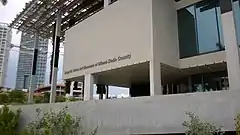

Museums
- Bass Museum of Art, Miami Beach
- Coral Castle, Homestead Miami
- Coral Gables Police and Fire Station, Coral Gables
- Fairchild Tropical Botanic Garden, Coral Gables
- Frost Art Museum, (Florida International University, Miami)
- Gold Coast Railroad Museum, Miami
- HistoryMiami, Downtown Miami
- Holocaust Memorial, Miami Beach
- Jewish Museum of Florida, Miami Beach
- Lowe Art Museum, (University of Miami, Coral Gables)
- Miami Children's Museum, Miami
- Museum of Contemporary Art, North Miami
- Pérez Art Museum Miami, Miami
- Phillip and Patricia Frost Museum of Science, Miami
- Vizcaya Museum and Gardens, Miami
- Wings Over Miami Museum, Miami
- Wolfsonian, (Florida International University, Miami Beach)
Culture and wildlife
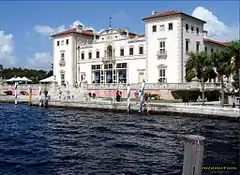

- Adrienne Arsht Center for the Performing Arts, Downtown Miami
- Ancient Spanish Monastery, North Miami Beach
- Bayfront Park Amphitheatre, Downtown Miami
- Bayside Marketplace, Downtown Miami
- Colony Theatre, Miami Beach
- Florida Grand Opera, Miami
- Gusman Center for the Performing Arts, Downtown Miami
- Jungle Island, Miami
- Miami New Drama, Miami Beach
- Miami Seaquarium, Miami
- Monkey Jungle, Miami
- Vizcaya Museum and Gardens, Miami
- Wertheim Performing Arts Center, (Florida International University, Miami)
- Zoo Miami, Miami
Other areas and attractions
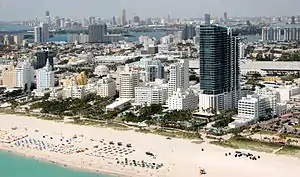
|
|
|
|
Parks
|
|
Sports venues
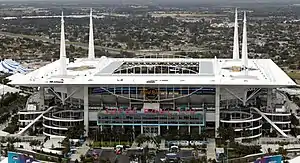
.jpg.webp)
Miami-Dade County holds the majority of sports arenas, stadiums and complexes in South Florida. Some of these sports facilities are:
- Hard Rock Stadium – Miami Dolphins (football) and plays host to the Miami Hurricanes football team during their regular season.
- LoanDepot Park – Miami Marlins (baseball)
- FTX Arena (formerly American Airlines Arena) – Miami Heat (basketball)
- Tennis Center at Crandon Park – Sony Ericcson Open
- Riccardo Silva Stadium – FIU Panthers (football)
- Ocean Bank Convocation Center – FIU Panthers (basketball)
- Infinity Insurance Park – FIU Panthers (baseball)
- Watsco Center – Miami Hurricanes (basketball)
- Alex Rodriguez Park at Mark Light Field – Miami Hurricanes (baseball)
- Cobb Stadium - Miami Hurricanes (soccer, track and field)
- Tropical Park Stadium
- Homestead-Miami Speedway
- Calder Race Course
- Hialeah Park Race Track
Former venues include:
- Bobby Maduro Miami Stadium
- Miami Arena
- Miami Orange Bowl
- Miami Marine Stadium
Planned:
- Miami MLS stadium
Transportation
Airports
Miami International Airport, in an unincorporated area in the county, is the Miami area's primary international airport. One of the busiest international airports in the world, it serves over 35 million passengers a year. Identifiable locally, as well as several worldwide authorities, as MIA or KMIA, the airport is a major hub and the single largest international gateway for American Airlines, the world's largest passenger air carrier. Miami International is the United States’ third largest international port of entry for foreign air passengers (behind New York's John F. Kennedy International Airport and Los Angeles International Airport), and is the seventh largest such gateway in the world. The airport's extensive international route network includes non-stop flights to over seventy international cities in North and South America, Europe, Asia, and the Middle East.
- Homestead General Aviation Airport
- Miami Executive Airport
- Opa-Locka Executive
- Homestead Air Reserve Base, east of Homestead in an unincorporated area, serves military traffic.
- Miami Seaplane Base
- Dade-Collier
Public transit
Public transit in Miami-Dade County is operated by Miami-Dade Transit,[108] and is the largest public transit in Florida. Miami-Dade Transit operates a heavy rail metro system Metrorail, an elevated people mover in Downtown Miami, Metromover and the bus system, Metrobus.[109]
Brightline and Tri-Rail which are Inter-city rail also services the county.
Major expressways
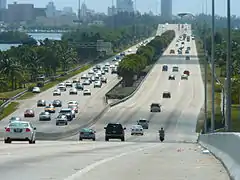
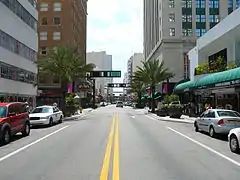

Miami-Dade County has 10 major expressways and one minor expressway in Downtown Miami:
 I-75
I-75 I-95
I-95
 I-195 / SR 112
I-195 / SR 112
 I-395 / SR 836
I-395 / SR 836 US 1
US 1 US 27
US 27 US 41
US 41 US 441
US 441 SR A1A
SR A1A Florida's Turnpike
Florida's Turnpike Florida's Turnpike Extension
Florida's Turnpike Extension SR 826
SR 826 SR 874
SR 874 SR 878
SR 878 SR 924
SR 924
County roads
This is a list of Miami-Dade county roads. Miami-Dade County has fewer county roads than any other county in Florida, despite its large population. None are signed.
| # | Road Name(s) | Direction and Termini | Notes | ||||
|---|---|---|---|---|---|---|---|
| Ives Dairy Road | SR 817 | US 1 | former SR 854 (east of US 441)[110] | ||||
| Crandon Boulevard / Rickenbacker Causeway | extension of SR 913 | ||||||
| Lindgren Road | extension of SR 825 | ||||||
| Southwest 57th Avenue | extension of SR 959 | ||||||
| Galloway Road | extension of SR 973 | ||||||
| Coral Reef Drive | extension of SR 992 | ||||||
| Northwest 67th Avenue Northwest 68th Avenue |
N/S | SR 826 | Palm Springs North | Broward County line | Palm Springs North | ||
Sources:
- FDOT Map of Miami-Dade County, Florida
- FDOT GIS data, accessed January 2014
Street grid
A street grid stretches from downtown Miami throughout the county. This grid was adopted by the City of Miami following World War I after the United States Post Office threatened to cease mail deliveries in the city because the original system of named streets, with names often changing every few blocks and multiple streets in the city sharing the same name, was too confusing for the mail carriers.[111] The new grid was later extended throughout the county as the population grew west, south, and north of city limits.
The grid is laid out with Miami Avenue as the meridian going north–south and Flagler Street the baseline going east-west. The grid is primarily numerical so that, for example, all street addresses north of Flagler and west of Miami Avenue have NW in their address (e.g. NW 27th Avenue). Because its point of origin is in downtown Miami which is close to the coast, the NW and SW quadrants are much larger than the SE and NE quadrants. Many roads, especially major ones, are also named, although, with a few notable exceptions, the number is in more common usage among locals.
Although this grid is easy to understand once one is oriented to it, it is not universal in the entire county. Hialeah uses its own grid system which is entirely different in its orientation. Coral Gables and Miami Lakes use named streets almost exclusively, and various smaller municipalities such as Florida City and Homestead use their own grid system along with the Miami-Dade grid system adding to the confusion. In the beach cities and parks of Miami Beach, Surfside, Bal Harbour, Sunny Isles, and Golden Beach, the streets are coordinated with the main grid; however, their avenues are named.
Sister cities
Miami-Dade County's sister cities are:[112]
 Aix-Marseille-Provence, France
Aix-Marseille-Provence, France Province of Asti, Italy
Province of Asti, Italy Asunción, Paraguay
Asunción, Paraguay The Bahamas
The Bahamas Cape Town, South Africa
Cape Town, South Africa County Cork, Ireland
County Cork, Ireland Dakar, Senegal
Dakar, Senegal Kingston, Jamaica
Kingston, Jamaica Maldonado, Uruguay
Maldonado, Uruguay Mendoza Province, Argentina
Mendoza Province, Argentina Monagas State, Venezuela
Monagas State, Venezuela New Taipei, Taiwan
New Taipei, Taiwan Paramaribo, Suriname
Paramaribo, Suriname Pereira, Colombia
Pereira, Colombia Petit-Goâve, Haiti
Petit-Goâve, Haiti Prague, Czech Republic
Prague, Czech Republic San José, Costa Rica
San José, Costa Rica Santo Domingo, Dominican Republic
Santo Domingo, Dominican Republic São Paulo, Brazil
São Paulo, Brazil Stockholm County, Sweden
Stockholm County, Sweden Tenerife, Spain
Tenerife, Spain Veracruz, Mexico
Veracruz, Mexico Viareggio, Italy
Viareggio, Italy Curitiba, Brazil[113]
Curitiba, Brazil[113]
See also
- Gentrification of Miami
- List of tallest buildings in Miami
- List of tallest buildings in Sunny Isles Beach
- List of tallest buildings in Miami Beach
- National Register of Historic Places listings in Miami-Dade County, Florida
- List of counties in Florida
- West End (Florida)
References
- "Counties Gazetteer" (TXT). 2.census.gov. Retrieved February 2, 2022.
- "Agencies and Officials". 8.miamidade.gov.
- "Miami-Dade County High Point - Peakbagger.com". Peakbagger.com.
- "Explore Census Data". Data.census.gov.
- "U.S. Census Bureau QuickFacts: Miami-Dade County, Florida". Census.gov.
- "GDP by County | U.S. Bureau of Economic Analysis (BEA)". Bea.gov.
- "Explore Census Data". data.census.gov. Retrieved December 7, 2021.
- "MiamiHerald.com". Miami Herald.
- "Find a County". National Association of Counties. Retrieved June 7, 2011.
- "Miami-Dade County Municipalities". www8.miamidade.gov. Archived from the original on February 21, 2019. Retrieved May 22, 2022.
- "Biscayne Bay Aquatic Preserves | Florida Department of Environmental Protection". floridadep.gov.
- "Biscayne Bay Aquatic Preserve". Florida Department of Environmental Protection. Florida Department of Environmental Protection. July 8, 2015. Retrieved December 14, 2015.
- Parks, Arva Moore (1991). Miami: The Magic City. Miami: Centennial Press. p. 12. ISBN 0-9629402-2-4.
- "Miami Circle to Brickell Avenue – From Native to NOW! – HistoryMiami Museum". Historymiami.org. Archived from the original on February 14, 2012. Retrieved April 5, 2012.
- Parks, p 13
- Parks, p 14
- Parks, p 14-16
- History of Miami-Dade county retrieved January 26, 2006 Archived January 10, 2006, at the Wayback Machine
- Publications of the Florida Historical Society. Florida Historical Society. 1908. p. 30.
- "Miami-Dade County Annual Report for Bondholders. For the Fiscal Year of 1998" (PDF). Miami-Dade County, Florida. 1998. Retrieved April 7, 2007.
- History of Indian Key – retrieved September 13, 2007
- Muir, Helen. (1953) Miami, U.S.A. Coconut Grove, Florida. Hurricane House Publishers. Pp. 33, 100
- "Miami-Dade County Government". Archived from the original on April 3, 2007.
- Fla. Const. of 1885, art. VIII, s. 11(h), continued in force by, Fla. Const. art. VIII, s. 9(e).
- "Miami-Dade County, FL Weather - USA.com™". Usa.com.
- "US Gazetteer files: 2010, 2000, and 1990". United States Census Bureau. February 12, 2011. Retrieved April 23, 2011.
- "Notes on Florida Geography, Florida International University". Fiu.edu.
- "U.S. Decennial Census". United States Census Bureau. Retrieved June 15, 2014.
- "Historical Census Browser". University of Virginia Library. Retrieved June 15, 2014.
- "Population of Counties by Decennial Census: 1900 to 1990". United States Census Bureau. Retrieved June 15, 2014.
- "Census 2000 PHC-T-4. Ranking Tables for Counties: 1990 and 2000" (PDF). United States Census Bureau. Retrieved June 15, 2014.
- "State & County QuickFacts". United States Census Bureau. Archived from the original on May 19, 2001. Retrieved November 6, 2015.
- "Explore Census Data". data.census.gov. Retrieved February 9, 2022.
- "Explore Census Data". data.census.gov. Retrieved February 9, 2022.
- "Miami-Dade County: Selected Social Characteristics in the United States 2006–2010 American Community Survey 5-Year Estimates". United States Census Bureau. Retrieved October 19, 2015.
- "Miami–Dade County Demographic Characteristics". ocala.com. Archived from the original on January 31, 2016. Retrieved October 19, 2015.
- "Hispanic or Latino by Type: 2010 Census Summary File 1". United States Census Bureau. Retrieved October 19, 2015.
- "Miami-Dade County, Florida First Ancestry Reported Universe: Total population – 2006–2010 American Community Survey 5-Year Estimates". United States Census Bureau. Retrieved November 11, 2015.
- "3.2% county population rise in year". Miami Today. July 18, 2013. Retrieved September 8, 2013.
- "Miami-Dade County: Age Groups and Sex: 2010 Census Summary File 1". United States Census Bureau. Retrieved October 19, 2015.
- "Miami-Dade County, Florida: Selected Economic Characteristics – 2006–2010 American Community Survey 5-Year Estimates". United States Census Bureau. Retrieved November 14, 2015.
- "Regulatory and Economic Resources - Miami-Dade County" (PDF). Miamidade.gov. Archived from the original (PDF) on February 16, 2008. Retrieved December 18, 2007.
- "Regional & Local Profiles". flhousingdata.shimberg.ufl.edu. Archived from the original on January 27, 2008. Retrieved December 18, 2007.
- "Demographics of Miami-Dade County, FL". MuniNetGuide.com. Archived from the original on June 7, 2008. Retrieved June 23, 2008.
- "Miami-Dade County, FL Detailed Profile: 2000 Census". city-data.com. Retrieved June 23, 2008.
- "Modern Language Association Data Center Results of Miami-Dade County, Florida". Modern Language Association. Retrieved July 27, 2013.
- "The Association of Religion Data Archives | Maps & Reports".
- "County Membership Report Miami-Dade County (Florida)". The Association of Religion Data Archives. 2010. Retrieved January 2, 2020.
- "Social Capital Variables Spreadsheet for 2014". PennState College of Agricultural Sciences, Northeast Regional Center for Rural Development. December 8, 2017. Retrieved December 30, 2019.
- "verso". Cdm17273.contentdm.oclc.org. Retrieved February 2, 2022.
- "Statues & Constitution". Online Sunshine. Article 7, Section 1 of the Constitution of Florida (1968). Retrieved May 20, 2022.
- "Statues & Constitution". Online Sunshine. Article 7, Section 6 of the Constitution of Florida (1968). Retrieved May 20, 2022.
- "January 6 Amendment 10 Consideration" (PDF). Miami-Dade County. p. 1. Retrieved May 20, 2022.
- "Statutes & Constitution". Online Sunshine. Article 5, Section 16, 17 and 18 of the Constitution of Florida (1968). Retrieved May 20, 2022.
- "January 6 Amendment 10 Consideration" (PDF). Miami-Dade County. January 6, 2022. History of the Sheriff in Miami-Dade County. Retrieved May 20, 2022.
- Rodriguez, Sabrina (November 4, 2020). "How Miami Cubans disrupted Biden's path to a Florida win". Politico. Retrieved November 8, 2020.
- Leip, David. "Dave Leip's Atlas of U.S. Presidential Elections". uselectionatlas.org.
- "Voter Registration Statistics". dos.myflorida.com.
- "Active Voter Party-Race Analysis" (PDF). Miamidade.gov. Retrieved February 2, 2022.
- "Largest employers in South Florida," South Florida Business Journal, September 24, 2021
- "100 of the largest hospitals and health systems in America," Becker's Hospital Review
- "Contact Us Archived December 28, 2009, at the Wayback Machine." Brightstar Corporation. Retrieved on January 9, 2010.
- "We're Listening Archived July 25, 2008, at the Wayback Machine." Burger King. Retrieved on January 31, 2009.
- "Contact Us Archived April 26, 2009, at the Wayback Machine." Intradeco Holdings. Retrieved on January 9, 2010.
- "Contact Us Archived May 14, 2011, at the Wayback Machine." Latin Flavors. Retrieved on January 9, 2010.
- http://www.ncl.com/nclweb/contactUs.html;jsessionid=LJQGQS4Fn2NYC0v4zCFMmjyv8LKvPRC5!-27535706
- "Contact Us." Ryder. Retrieved on January 9, 2010.
- "Contact Us Archived August 2, 2010, at the Wayback Machine." (Direct link to image Archived May 12, 2011, at the Wayback Machine) Centurion Air Cargo. Retrieved on July 1, 2010. "Head Office 1851 NW 68 Ave., Bldg 706 Miami, FL 33126. This address may incorrectly be mapped to a residential subdivision. The proper location is at Miami International Airport
- Home page Archived November 6, 2005, at the Wayback Machine. Florida West International Airways. Retrieved on January 7, 2010.
- "Locations Archived April 14, 2008, at the Wayback Machine." International Bonded Couriers. Retrieved on January 9, 2010.
- "Contact World Atlantic Airlines Archived January 15, 2013, at the Wayback Machine." World Atlantic Airlines. Retrieved on December 31, 2012. "5600 NW 36th Street Suite: 450 Miami, Florida 33166"
- "MIA LOST AND FOUND PUBLIC AUCTION ON MARCH 20 Archived March 12, 2013, at the Wayback Machine." Miami International Airport. March 9, 2010. Retrieved on December 31, 2012. "5600 N.W. 36th Street (Building 845), Third Floor"
- "Office Locations." Hewlett Packard. Retrieved on August 29, 2011. "Hewlett-Packard Latin America Waterford Building, 9th Floor 5200 Blue Lagoon Drive Miami, Florida 33126 USA"
- "USA." AstraZeneca. Retrieved on March 11, 2010.
- "Contact Us Archived March 3, 2012, at the Wayback Machine." Gate Group. Retrieved on September 17, 2011. "North America Regional Office11710 Plaza America Drive, Suite 800 Reston, VA 20190 USA"
- "Prelude Archived February 2, 2011, at the Wayback Machine." (Select "English", then select the mail icon in the upper right hand corner of the screen) Unicomer Group. Retrieved on March 4, 2010.
- "Contact Us." Goya Foods. Retrieved on March 26, 2016. "Goya Foods of Miami 13300 NW 25th Street Miami, FL 33182"
- "Contact Us." Arrow Air. Retrieved on January 7, 2010.
- "Walkout by 3,500 Cancels All Flights Of National Airlines." The New York Times. Sunday February 1, 1970. Page 58. Retrieved on September 24, 2009.
- "World Airline Directory." Flight International. March 14–20, 1990 "Airlift International" 57.
- "World Airline Directory." Flight International. March 23–29, 1994. 114. "Head office: PO Box 522067, 5400 NW 36th St, Miami, Florida 33152, USA."
- Bernstein, Aaron. Grounded: Frank Lorenzo and the Destruction of Eastern Airlines. Beard Books, 1999. 22. Retrieved on August 28, 2009.
- "World Airline Directory." Flight International. March 30, 1985. 72." Retrieved on June 17, 2009.
- Stieghorst, Tom. "Sings of decline." Sun Sentinel. May 6, 1991. Weekly Business 8. Retrieved on August 28, 2009.
- "Welcome to ResidenSea." ResidenSea. January 18, 2006. Retrieved on January 20, 2010.
- Beacon Council Archived September 21, 2012, at the Wayback Machine. Beacon Council. Retrieved on May 4, 2013.
- "Southern Florida 2005 Okra PMSP". Regional Integrated Pest Management Centers Database. 2022. Retrieved June 30, 2022.
- "HS-857/TR009: Okra Production in Miami-Dade County, Florida". Electronic Data Information Source (EDIS). Institute of Food and Agricultural Sciences (IFAS), UF. 2021. HS-857 TR009. Retrieved September 17, 2022.
- Dittmar, Peter; Agehara, Shinsuke; Dufault, Nicholas (August 16, 2022). "Vegetable Production Handbook of Florida 2022–2023". Edis. Institute of Food and Agricultural Sciences (IFAS), UF. doi:10.32473/edis-cv292-2022. ISSN 2576-0009 – via University of Florida George A. Smathers Libraries.
-
- • Storer, Nicholas P.; Kubiszak, Mary E.; King, J. Ed; Thompson, Gary D.; Santos, Antonio Cesar (2012). "Status of resistance to Bt maize in Spodoptera frugiperda: Lessons from Puerto Rico". Journal of Invertebrate Pathology. Academic Press (Elsevier, Society for Invertebrate Pathology). 110 (3): 294–300. doi:10.1016/j.jip.2012.04.007. PMID 22537834. S2CID 20078891.
- • Tabashnik, Bruce E.; Brévault, Thierry; Carrière, Yves (2013). "Insect resistance to Bt crops: lessons from the first billion acres". Nature Biotechnology. Nature Portfolio. 31 (6): 510–521. doi:10.1038/nbt.2597. ISSN 1087-0156. PMID 23752438. S2CID 205278530.
- • Tabashnik, Bruce E.; Carrière, Yves (2017). "Surge in insect resistance to transgenic crops and prospects for sustainability". Nature Biotechnology. Nature Portfolio. 35 (10): 926–935. doi:10.1038/nbt.3974. ISSN 1087-0156. PMID 29020006. S2CID 2882631. BET ORCID: 0000-0002-2430-2367).
- • Tabashnik, Bruce E.; Mota-Sanchez, David; Whalon, Mark E.; Hollingworth, Robert M.; Carrière, Yves (2014). "Defining Terms for Proactive Management of Resistance to Bt Crops and Pesticides". Journal of Economic Entomology. Oxford University Press (Entomological Society of America). 107 (2): 496–507. doi:10.1603/ec13458. ISSN 0022-0493. PMID 24772527. S2CID 11761620.
- • Harrison, Rhett D.; Thierfelder, Christian; Baudron, Frédéric; Chinwada, Peter; Midega, Charles; Schaffner, Urs; van den Berg, Johnnie (2019). "Agro-ecological options for fall armyworm (Spodoptera frugiperda JE Smith) management: Providing low-cost, smallholder friendly solutions to an invasive pest". Journal of Environmental Management. Elsevier. 243: 318–330. doi:10.1016/j.jenvman.2019.05.011. ISSN 0301-4797. PMID 31102899. S2CID 158047487.
- • Dhadialla, Tarlochan S.; Gill, Sarjeet S. (2014). Insect Midgut and Insecticidal Proteins. Advances in Insect Physiology. Vol. 47. London, England: Elsevier. doi:10.1016/c2013-0-12819-x. ISBN 978-0-12-800197-4. ISSN 0065-2806. OCLC 891383494.
- "Bactrocera zonata". Perdue University. pp. 1–12.
- Wetterer, James; Porter, Sanford (2003). "The Little Fire Ant Wasmannia auropunctata: Distribution, Impact and Control". Sociobiology. 41 (3). ISSN 0361-6525. S2CID 53132506. CABI ISC # 20043012612. AGRIS ID US201300806939.
- "little fire ant - Wasmannia auropunctata (Roger)". University of Florida Entomology and Namatology. April 2021. Retrieved October 22, 2022.
- "Locations". Miami-Dade Fire Rescue Department. Miami-Dade County. Archived from the original on June 15, 2006. Retrieved August 30, 2006.
- "Airport Fire Rescue Division". Miami-Dade Fire Rescue Department. Miami-Dade County. Archived from the original on March 8, 2005. Retrieved August 30, 2006.
- "Cities Served". Miami-Dade Fire Rescue Department. Miami-Dade County. Archived from the original on October 22, 2004. Retrieved August 30, 2006.
- "Miami-Dade County News Releases" (PDF). Miami-Dade County. January 28, 2016.
- "Water & Sewer - Miami-Dade County". Miamidade.gov. Archived from the original on October 9, 2006. Retrieved July 11, 2007.
- "Miami International Airport". Miami-airport.com.
- "Miami-Dade Regional Juvenile Detention Center." Florida Department of Juvenile Justice. Retrieved on June 4, 2010.
- "front cover". Cdm17273.contentdm.oclc.org. Retrieved February 2, 2022.
- "page 03". Cdm17273.contentdm.oclc.org. Retrieved February 2, 2022.
- "About Us - Miami-Dade Public Library System". mdpls.org. Retrieved October 21, 2021.
- "CONTENTdm". Cdm17273.contentdm.oclc.org. Retrieved February 2, 2022.
- "2020 CENSUS - SCHOOL DISTRICT REFERENCE MAP: Miami-Dade County, FL" (PDF). U.S. Census Bureau. Retrieved July 22, 2022. - Text list - As "Dade County School District"
- "Digest of Education Statistics, 2016". nces.ed.gov. Retrieved November 27, 2018.
- "Find a Branch | Locations of the Miami-Dade Public Library System". Mdpls.org. Retrieved November 27, 2018.
- "Transportation & Public Works". Miamidade.gov.
- "Miami-Dade County News" (PDF). Miamidade.gov. February 1, 2016.
- "General highway map Dade County". ufdc.ufl.edu.
- Muir, Helen. (1953) Miami, U.S.A. Coconut Grove, Florida: Hurricane House Publishers. Pp. 136–7.
- "Miami-Dade County Sister Cities Program". miamidade.gov. Miami-Dade County. Retrieved December 17, 2021.
- "Curitiba ganha nova cidade-irmã nesta quarta-feira; saiba qual". Curitiba.pr.gov.br (in Portuguese). Retrieved April 7, 2022.
